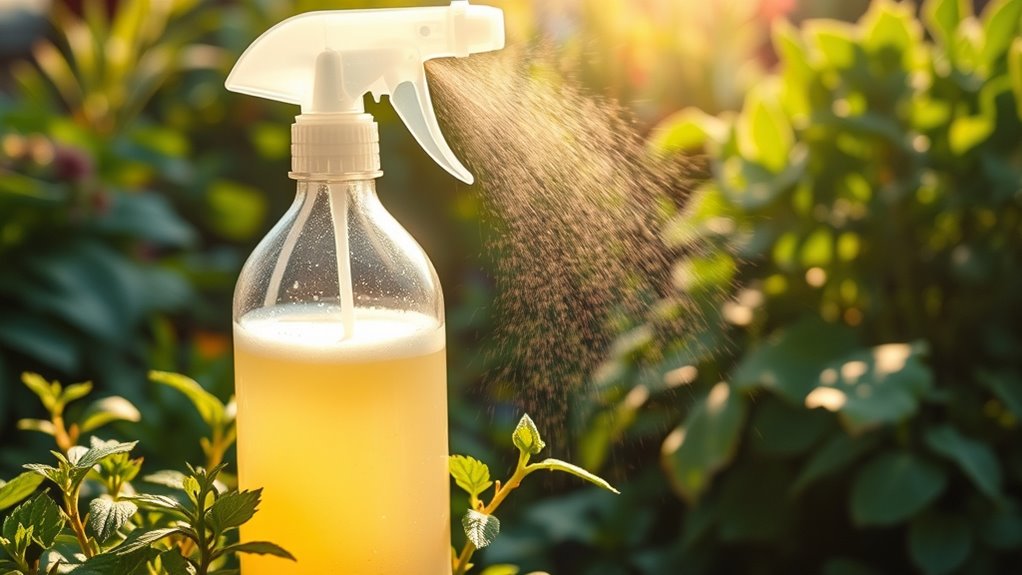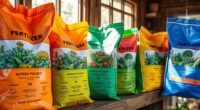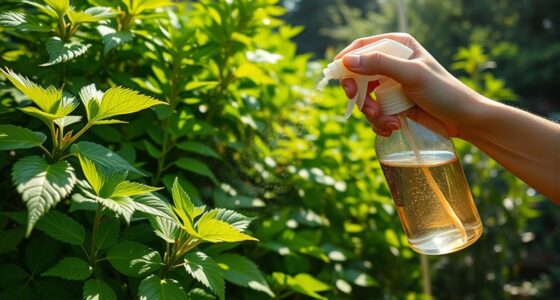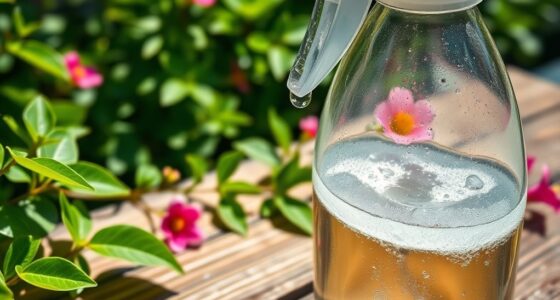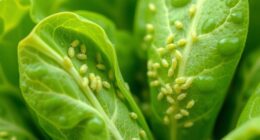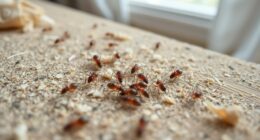To make a DIY natural insecticide, mix 1-2 teaspoons of biodegradable liquid soap with a quart of water and stir well. Always do a patch test first, then spray affected plants, focusing on undersides of leaves. Apply early morning or late evening to protect beneficial insects and avoid sunburn. Reapply every few days until pests decline. Want to learn more about creating safe, effective soap sprays for your garden? Keep exploring for helpful tips!
Key Takeaways
- Mix biodegradable liquid soap with water (1-2 teaspoons per quart) to create an effective, gentle homemade insecticide.
- Conduct a patch test before full application to ensure plants’ safety and avoid damage.
- Spray on affected plant areas, especially undersides of leaves, in early morning or late evening to protect beneficial insects.
- Most effective against soft-bodied pests like aphids, spider mites, and whiteflies, with regular reapplications for best results.
- Supports eco-friendly gardening by reducing chemical use, promoting beneficial insects, and maintaining a balanced garden ecosystem.
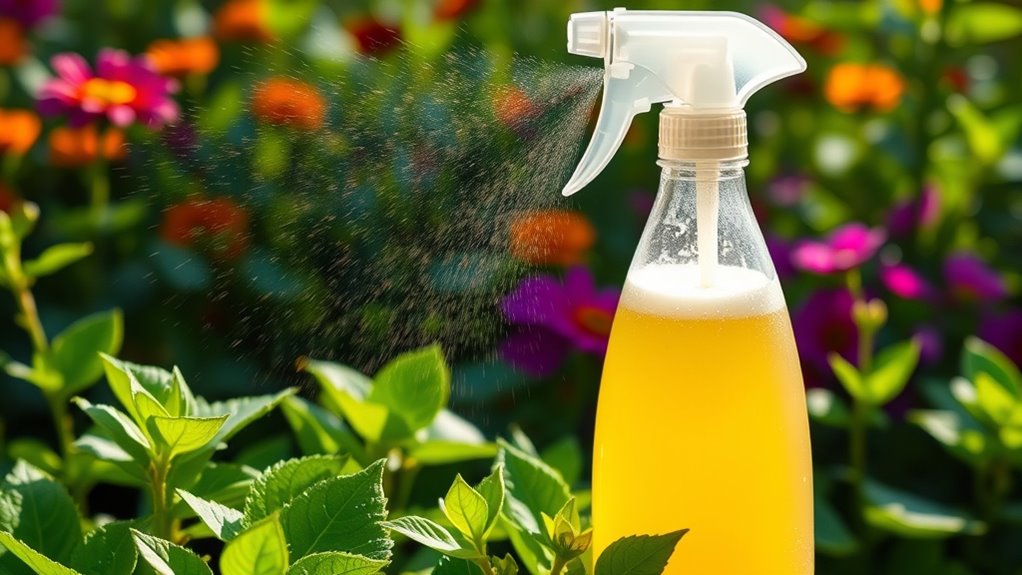
Are you tired of using chemical insecticides that harm your garden and the environment? If so, switching to natural solutions like soap sprays can make a significant difference. Unlike traditional chemicals, soap sprays are gentle on beneficial insects, such as ladybugs and pollinators, which play vital roles in maintaining your garden’s health. When you choose these chemical alternatives, you help create a balanced ecosystem where pests are kept in check without disrupting the natural predator-prey relationships. Plus, soap sprays are easy to prepare at home, cost-effective, and safe for your family and pets.
Switch to soap sprays for a gentle, eco-friendly pest control that protects beneficial insects and your garden’s health.
To make a basic soap spray, you’ll need just a few ingredients. The most common recipe involves mixing a small amount of biodegradable liquid soap with water. Typically, about one to two teaspoons of soap per quart of water is enough. Avoid using harsh detergents or soaps with added fragrances and dyes, as these can damage plants or harm beneficial insects. Once you’ve combined the ingredients, stir well to ensure the soap dissolves completely. Transfer the mixture to a spray bottle for easy application.
Before applying the soap spray broadly, it’s wise to do a patch test on a small section of your plants. Wait 24 hours to see if there’s any adverse reaction, such as leaf browning or wilting. If your plants tolerate the spray well, you can proceed to spray the affected areas, focusing on the undersides of leaves where pests often hide. Apply in the early morning or late evening to minimize potential harm to beneficial insects and avoid direct sunlight, which can cause the soap to burn leaves.
Using soap sprays regularly can help control soft-bodied pests like aphids, spider mites, and whiteflies. Keep in mind, though, that soap sprays are most effective against these pests and may not eliminate larger or more resilient insects like beetles or caterpillars. The key is consistency—reapply every few days until you see a decline in pest activity. Because this method is a chemical alternative, it’s safe to use frequently without the risk of building up harmful residues in your soil or plants.
Incorporating soap sprays into your gardening routine not only reduces reliance on harmful chemicals but also encourages a healthier environment for beneficial insects. These natural insecticides support your goal of sustainable gardening by protecting your plants and fostering a thriving, balanced ecosystem. Proper color accuracy in application and formulation of your soap spray can enhance its effectiveness against pests while minimizing any potential damage to your plants. So, next time pests invade your garden, remember that a simple, homemade soap spray can be your effective, eco-friendly weapon.
Frequently Asked Questions
How Long Does a Soap Spray Treatment Last?
A soap spray treatment typically lasts about a week, but this depends on factors like pest resistance and spray coverage. If pests develop resistance or if coverage isn’t thorough, you’ll need to reapply sooner. Consistent, even application helps maximize effectiveness and extends the treatment’s duration. Keep an eye on your plants, and reapply as needed to maintain pest control, especially after heavy rain or wind which can wash away the spray.
Can Soap Sprays Harm Beneficial Insects?
You might wonder if soap spray impact harms beneficial insects. Generally, soap sprays are safe when used correctly, but they can affect beneficial insects if applied excessively or during peak activity times. To guarantee beneficial insect safety, apply soap sprays early in the morning or late in the evening when these insects are less active. Careful application minimizes harm, balancing pest control with protecting helpful insects in your garden.
What Is the Best Time of Day to Apply?
You should apply soap sprays early in the morning or late in the afternoon, considering timing considerations and environmental factors. During these times, temperatures are cooler, reducing the risk of plant damage and evaporation. Applying when beneficial insects are less active helps protect them while ensuring your spray effectively targets pests. Avoid midday applications to prevent leaf burn and maximize the insecticide’s effectiveness in your garden.
Are Soap Sprays Safe for Edible Plants?
It’s a coincidence that soap sprays are generally safe for edible plants when used properly. You should prioritize plant safety by applying soap sprays during the early morning or late evening, avoiding excess. This helps prevent pesticide residue buildup and minimizes harm to beneficial insects. When used correctly, soap sprays are an effective, natural pest control method that doesn’t compromise the safety of your harvest.
How Often Should I Reapply Soap Sprays?
You should reapply soap sprays every 7 to 10 days to maintain effective pest control. Consistent spray application prevents pests from developing resistance, keeping your plants healthy. Be sure to monitor your plants and reapply promptly if pests reappear or after heavy rain, which can wash away the spray. Maintaining spray consistency helps ensure your natural insecticide works effectively without harming your edible plants.
Conclusion
Think of your garden as a delicate symphony, where each plant plays a essential note. By using soap sprays as your gentle conductor, you guide pests away without disrupting the harmony. With just a simple, natural tool, you become the maestro of a thriving, pest-free oasis. Embrace this DIY approach, and let your garden flourish in balanced beauty—an elegant dance of nature and nurture working in perfect tune.
